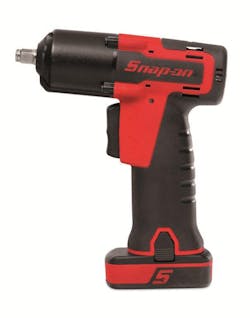Tool Review: Snap-on 14.4V MicroLithium Cordless Impact Wrench
The Snap-on 14.4V 3/8" Drive MicroLithium Cordless Impact, No. CT761, provides 120 ft/lbs of torque output and produces 2,500 rpms of free speed to handle a wide range of applications. The 3 nose-mounted LEDs illuminate the work area, and the CT761 warns the user if they are under voltage or over current, shutting down the impact before it overheats. The impact can access restricted applications, and a variable-speed, toggle-style trigger gives the user control, avoiding over-torquing or snapping fasteners. The tool weighs approximately 2.5 lbs with the 2.0Ah rechargeable battery, and the fuel gauge notifies the operator how much battery life remains. A quick chuck version of the tool (No. CT761QC) is also available.
The review
Daniel McGuinn of Realtoolreviews.com appreciated the many ways the Snap-on 14.4V 3/8” Drive MicroLithium Cordless Impact saved time on jobs, and Lou Fort – lead technician at K.A.R.S. Inc. in Huntingburg, Ind. – was impressed with the power and speed of the quick chuck (QC) version of the tool.
In addition to removing and installing fasteners quickly, McGuinn found the tool saved time because there were no cumbersome steps associated with pneumatic tools such as pressurizing air lines, connecting couplers and fighting with a hose. “Literally, you pick it up and it’s ready to go,” McGuinn says.
“Extremely easy to use and control,” McGuinn adds. “The rocker switch design versus a standard trigger – like most drills and impacts – proved to be very effective at not only applying torque to a fastener, but also in the removal of them. The electric brake works excellent, and as soon as the trigger is released, the socket immediately stops and the nut or bolt will stop turning.”
Fort, who also saw time savings when cleaning threads, says his favorite feature was the 104 ft/lbs of torque produced by the small, powerful and fast CT761QC – while McGuinn says the CT761 is advertised as having up 120 ft/lbs of torque but was able to remove fasteners torqued to 150 ft/lbs with ease.
“The amount of work I got done with a single charge was also impressive,” Fort adds. “Snap-on’s extended tool offerings for this one battery add to its value.”
The CT761 – which comes with two batteries, a fast charger, a protective tool bag and an owner’s manual – requires minimal set-up.
“Initial setup requires the tool’s batteries to be charged up,” Fort says, noting both of the power sources came with a 50 percent charge. “It took less than an hour to bring the first one up to a full charge. Since the CT761QC is the bit driver version, you also have to install your bit driver of choice.”
Fort used the CT761QC to remove and install the front eight lug wheel of a F-350; clean out the mounting holes of a used transfer case for a F-250; as well as brake work and suspension jobs.
“The last job I used it on is the one that impressed me the most,” Fort says. “I just got doing a ‘Cab off’ high pressure pump and full set of injectors on a 2008 K3500 HD with a 6.6L. I removed and installed every bolt including the cab mounts with the CT761QC all on a single battery. The only bolts I had to break loose by hand were the exhaust manifolds and turbo mounts – quite impressive.
McGuinn, who complimented the tool’s light weight and compact size, used the CT761 to assemble shop equipment among other tasks. He says the CT761 provided two distinct advantages – its size and its power.
“It is much narrower than a ‘full-size’ cordless impact and could be positioned very easily at any angle and also at arm’s length for extended periods of time as everything was aligned and leveled out properly,” he says. “The CT761 was able to easily remove lug nuts that had been installed in the middle of winter at roughly 90 to 100 ft/lbs, driven tens of thousands of miles. While 3/8” impacts are not designed for heavy duty applications like that, it is very nice to know that it had no issues performing when put to the test.”
Fort and McGuinn would prefer if the LEDs on the front had a time delay because once the user lets off the trigger, they turn off. “It would be nice to see a 5 to 10 second delay after the trigger is released so you can light up an area without the anvil spinning,” McGuinn says.
Additionally, Fort says the locking quick-connect chuck on the CT761QC has to be moved away, not toward, the tool to install and release an attachment.
“On more than one occasion the vibration was so intense that the bit holder released the bit during use,” he says, noting the battery isn’t always easy to remove either.
With potential those improvements to be considered, both McGuinn and Fort are impressed with the cordless impact.
“The difficulty encountered when changing batteries and occasional dislodging of the bits cast a small shadow over the tool’s otherwise impressive power and run-time,” Fort says.
“It really surprised me of the ease of use, as well as the unique design features that I do not normally see on cordless impacts,” McGuinn adds. “The battery status indicator next to the trigger is easy to see and understand. The trigger was very easy to use and control, and the power levels greatly exceeded my expectations.”

